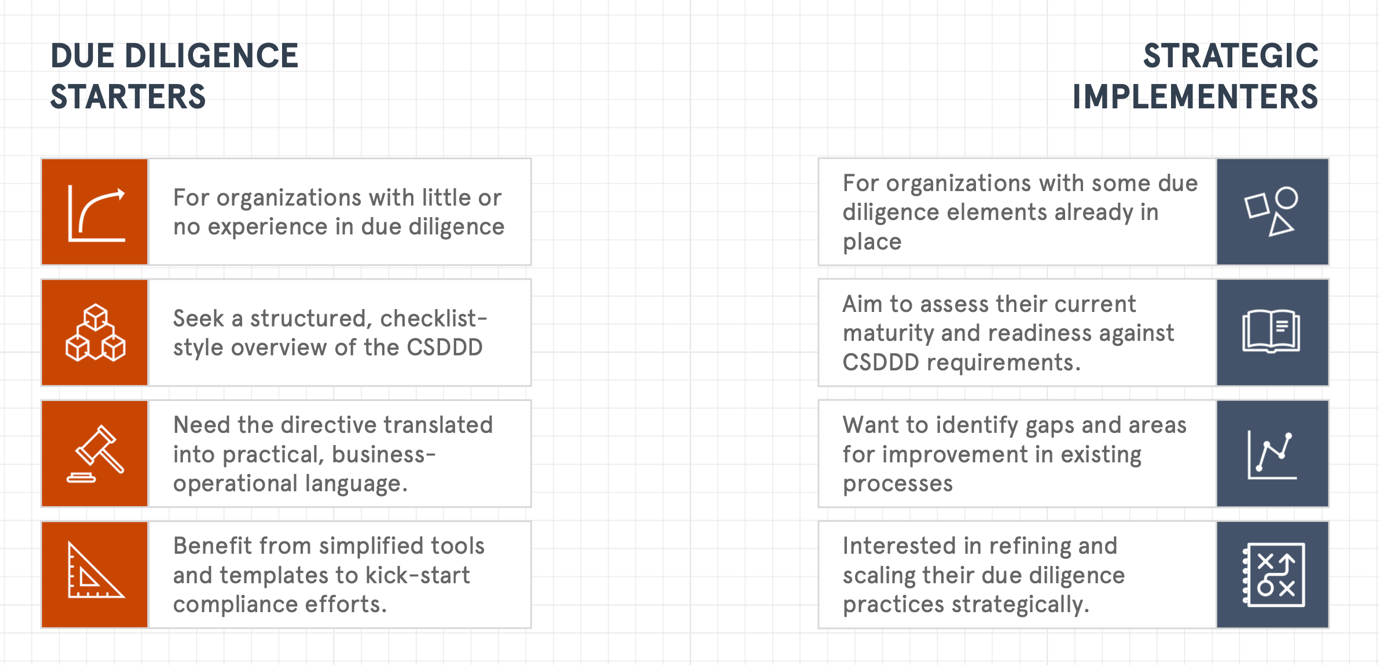Many companies are currently facing the same challenging question: how do we best prepare for the Corporate Sustainability Due Diligence Directive (CSDDD) in a way that’s both practical and strategic?
Together with Eliza Renda, Senior Human Rights Advisor at Ørsted, Mathias Hvam, Senior Advisor in Sustainable Development from Copenhagen Airports, and Nordic Sustainability’s CSDDD lead Anna Katharina Bierre, this webinar explored what CSDDD implementation looks like in real company settings, highlighting the value of Nordic Sustainability’s maturity tool and sharing lessons from putting it in practice.
What you need to know about due diligence
Sustainability due diligence is a structured, continuous process to identify, prevent, and mitigate risks to people and the environment across a company’s value chain.
Sustainability due diligence is not to be confused with the other types of due diligence, such as legal or transactional, which typically occur around specific events, like mergers and acquisitions. It builds on established international frameworks, particularly the OECD Due Diligence Guidance and the UN Guiding Principles on Business and Human Rights.
Read more on the 6 Step OECD Due Diligence Framework in our recent article.
Sustainability due diligence has evolved over time and is now taking shape in the form of CSDDD

With the adoption of the CSDDD in 2024, the EU has made this process a legal obligation. While changes may come through the EU Omnibus proposal, around 95% of the directive’s original requirements remain unaffected by the Omnibus proposal. Early and structured preparation is therefore still highly relevant when it comes to CSDDD.
Introducing the Nordic Sustainability CSDDD Maturity Tool
Anna Katharina Bierre outlined three steps companies should take before starting CSDDD implementation to ensure a targeted approach. These steps form the foundation of Nordic Sustainability’s CSDDD maturity service.
- Build knowledge and understand the directive: Many companies have already begun learning about the directive, but there’s often a deeper need to upskill teams across the organisation. Due diligence isn’t a task for a single department, it needs to be embedded throughout the organisation.
- Map your current maturity level and identify critical gaps: Mapping existing initiatives and identifying critical gaps helps prioritise where to act first.
- Create an implementation plan: These insights feed directly into a smart, phased implementation roadmap tailored to each company’s context.
The tool simplifies the legal text into operational questions, includes guidance from best practice and existing standards and dashboard visualisations. It’s part of a broader service package that includes detailed analysis, tailored workshops and strategic communication material to support effective leadership action and decision making.
Features of the CSDDD Maturity Tool

Results from using our approach include:
- A clear overview of the most critical areas to start addressing for effective implementation
- Inspiration, recommendations and tangible next steps for how to start implementing critical areas
- Enable client staff to feel comfortable in starting to implement
Two profiles: starters and strategic implementers
Companies typically fall into two broad categories when it comes to their readiness for CSDDD implementation: due diligence starters and strategic implementers, with many sitting somewhere in between.

- Starters are often new to the concept of sustainability due diligence. While they may not label their existing practices as such, most already have relevant processes in place under different names. These companies benefit from seeing the directive translated into practical, operational language and structured guidance.
- Strategic implementers have already engaged with international standards and begun embedding due diligence into their systems. For them, the tool helps identify remaining gaps and assess how closely their current approach aligns with the directive’s requirements.
Companies can benefit from the tool regardless of whether they see themselves as beginners or more advanced in their due diligence efforts.
Learnings from Ørsted: Start small and expand your stakeholder landscape
Eliza Renda positioned Ørsted as a strategic implementer. The company has existing due diligence systems in place, but the project helped them identify blind spots.
Here are some of her main takeaways from working with the CSDDD Maturity Tool:
- Start small: Finding and involving the right stakeholders took time but was essential. Begin with a core group and expand as the work matures.
- Account for complexity: As a global business with diverse technologies, Ørsted has different processes for different business units. The tool had to be adapted to reflect this structure.
- Bridge internal jargons: Human rights and environmental teams often work in silos. Eliza stressed the importance of finding shared language and practical ways of working together.
- The gap analysis is just the beginning: Ørsted chose to pilot only selected categories to get started. The work continues from there.
The structure of the tool goes beyond the directive. Eliza highlighted that while we don’t know what will happen with the CSDDD because of the Omnibus Proposal, the maturity tool prepares companies for covering a broad due diligence scope.
Learnings from CPH Airports: Use momentum and manage fatigue
Mathias Hvam shared CPH Airports’ perspective as a company in between starting and scaling. His key learnings are:
- The tool saved time: Translating legal requirements into operational language takes time. The tool provided a structured shortcut.
- Fatigue is real: Following CSRD implementation, there is a general fatigue in the sustainability field. The team is now working to embed CSDDD preparation within ongoing initiatives rather than as a standalone implementation.
- Company complexity equals CSDDD complexity: CPH Airports operates across multiple formats, such as retail, aeronautical activities, complex ground operations, each with unique due diligence needs.
- Synergies matter: One of the most valuable takeaways for CPH Airports was the potential to align CSDDD with existing systems, like CSRD reporting, ERM structures, and DMA processes. Instead of treating these as separate efforts, the focus is now on taking advantage of the positive synergies.
Final conclusions
Despite political uncertainty, companies are moving forward with due diligence to create real impact and unlock strategic value.
The webinar concluded by highlighting that the tool goes beyond the CSDDD – it helps companies take practical steps from where they are today, build momentum, and align with both regulatory demands and stakeholder expectations over time.


